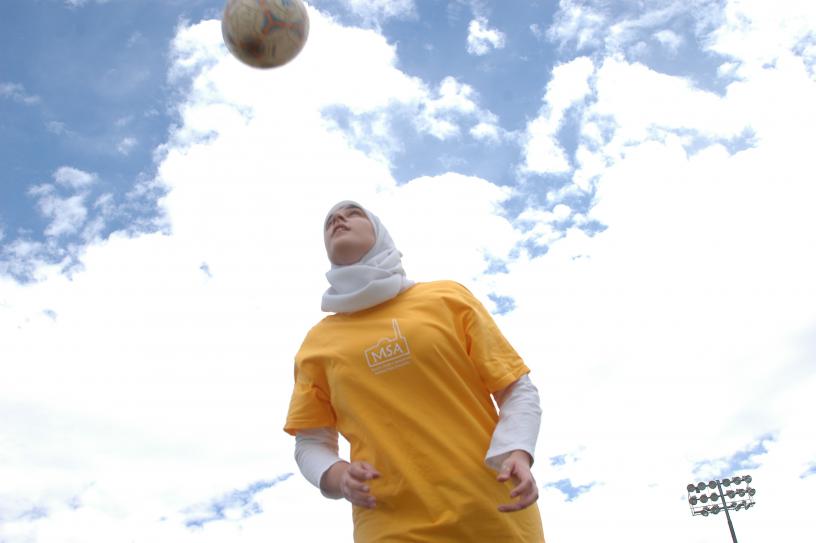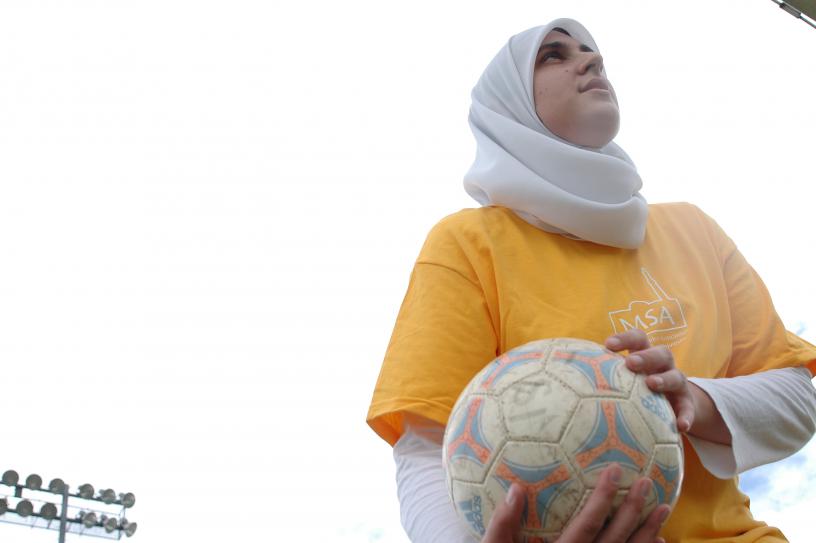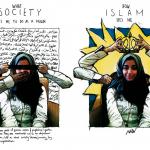In this exclusive selection of portraits from iCover, get to know seventeen unique Muslim women who all choose to wear the hijab through sports, at school, in the army, as a truck driver, and elsewhere in everyday life. Sadaf Syed’s sympathetic portraits dispel the stereotypes of Muslim women who cover.
After a long and arduous debate with myself, I decided to don the hijab (headscarf) back in 2001. I thought the decision to cover was solely about me and my relationship with my Creator, an inner and outer struggle to choose to veil one of my biggest sources of pride—my hair.
Once I decided to pin that yard and a half of fabric around my head, I thought I had reached the end of my self-conflict. Ah, how naive I was. I was soon to discover that, contrary to what I might believe, the hijab wasn’t just about me. It apparently means many things to many people. I was hailed as virtuous and pious and saintly amongst quite a few Muslims, and any social gaffes I made were viewed with the attitude of “You wear a head- scarf and you think you can say/do that?” To others on the street, I was backwards, ignorant, and in need of slow, clear instructions proclaimed in a loud, demeaning voice. God forbid that I should forget to signal while out on the road. “Go back home to the desert! Where’d you learn to drive, in a sandbox?!” If I wasn’t wearing the hijab, would anyone (even under the influence of road rage) have thought to use the word “desert”?
Some Muslim friends assumed that I now thought I was better than them, holier-than-thou and in a constant state of judgment, although my attitudes towards them hadn’t changed in the least. Trust me, I appreciate a new hair-style more than anyone, and never hesitate to compliment girlfriends on how attractive they are looking. My husband cringed at the idea of “wearing our religion on our faces,” and it was particularly difficult for him when we patronized a trendy new restaurant and were met with sideways glances. If there’s one thing I know for sure now, it’s that this light strip of cloth sure does carry a lot of weight.
For some Muslims and non-Muslims, hijab is strange because it goes against the trend of globalization and modernization. The muhajjibas (one who wears the hijab) explain that being a servant of God means being grateful to God and living life with the intention of pleasing one’s Creator. They have chosen to adopt the Divine definition of femininity and beauty and ignore the man-made one; they avert their minds and eyes from the messages that the billboards, magazine covers, and television ads scream out to them and the rest of humanity. They are not slaves to the trends and fashions of the day—stilettos this month, mini-skirts the next, shirts that reveal the outlines of breasts this year, jeans that expose lacy underwear the next. Their attire is as dependable and comfortable as an old friend: loose garments that drape curvy silhouettes, no worries about bad hair days (maybe the occasional bad hijab day), and a confidence that comes from being treated with respect for one’s mind and personality instead of one’s looks. Upon reflection, one realizes that the muhajjiba’s wardrobe is respectful to men as well, letting them know that she is not there to distract them or divert them from honorable work and intentions.
They say “a picture is worth a thousand words.” With that in mind, I set out four years ago on a cross-country trek to capture these stories. I pray you will be able to see beyond the loose garments and hijabs to witness the courageous hearts and intelligent minds that dwell within. I feel blessed to have met these “sisters in scarves” and I am now honored to introduce them to you. iCOVER is the real deal: A Day in the Life of a Muslim-American.

![Autumn Hardesty, U.S. Army Specialist: Life in the United States Army is a balancing act, and Autumn is simply trying to be all that she can be --- a Muslim-American. “[People] assume I have a different culture, that somehow I am less American because I am Muslim. Some people do accept me, but I have to be very cautious. I feel like I have to be on my best behavior all the time, which is a little stressful. If I make a mistake, non-Muslims will believe it is Islam and not me.”](https://muslima.globalfundforwomen.org/sites/default/files/styles/slideshow/public/images/324/01autumnhardesty.jpg?itok=sx-q4LNv)

















